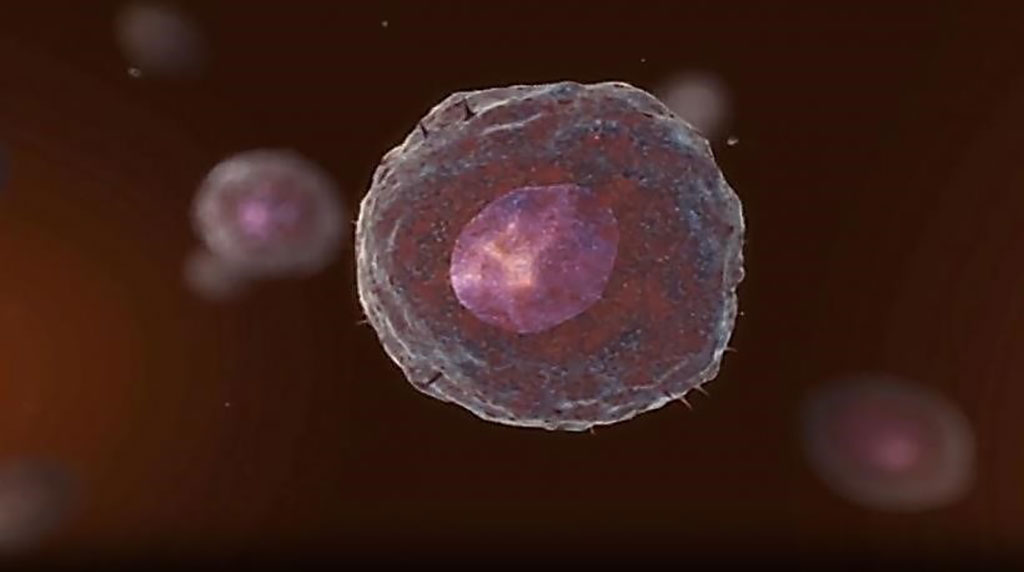Novel CTC Culture Method Developed to Study Metastatic Cancer
|
By LabMedica International staff writers Posted on 26 Oct 2020 |

Image: Circulating tumor cells (CTCs) are cancer cells that are released and disseminated into the bloodstream and lymphatic system. CTC cultures were successfully propagated from breast epithelial cells (Photo courtesy of Menarini Silicon Biosystems).
Cancer metastasis is responsible for most cancer-associated death. During metastasis, cells that escape the primary tumor into the circulatory system are known as circulating tumor cells (CTCs).
Circulating tumor cells represent a unique population of cells that can be used to investigate the mechanistic underpinnings of metastasis. Unfortunately, current technologies designed for the isolation and capture of CTCs are inefficient. Existing literature for in vitro CTC cultures report low (6% to 20%) success rates.
Scientists from Georgetown University Medical Center (Washington, DC, USA) enrolled from 12 metastatic breast cancer patients representing all three major subtypes, HER2 positive, hormone receptor positive, and triple negative and samples from five healthy donors. After collecting a patient's blood sample, the team removed red blood cells (RBCs) and granulocytes using gradient centrifugation. They then harvest the rest of the cells, including CTCs, and put them into a custom cell culture growth medium for culture, followed by downstream analysis.
To see whether they had indeed cultured CTCs, the group then tested for the presence of epithelial, mesenchymal, and breast tissue markers to establish the cells' tissue of origin using reverse-transcriptase quantitative polymerase chain reaction (qRT-PCR). They selected cytokeratin 5 and 8 and mammaglobin and successfully identified all three biomarkers in all 12 cultures. The team then used RNA-seq on the six samples that yielded sufficient RNA and could be cultured for more than 30 days in order to characterize their gene expression. These six samples all contained CD45+ leukocytes, they noted, which have previously been shown to support CTC survival.
Overall, the investigators identified 7,234 genes that were significantly differentially expressed in the CTCs-containing samples compared to the healthy donors. Increased expression of multiple genes was correlated with a significant drop in overall patient survival, they found. Using multiple bioinformatics tools to confirm that the CTCs in the samples originated from the cancers, the team identified 52 significantly enriched key cancer pathways and 21 enriched genes that are important to breast cancer progression and metastasis. The group mainly found enriched CD8 T cells, neutrophils, and macrophages in the CTC cultures and noted that the isolation technique appeared to favor the survival of macrophages and neutrophils.
Seema Agarwal, PhD, the senior author and associate professor of pathology, said, “We could take DNA and RNA from cultured CTCs and do a detailed genomic analysis that can be done very quickly in a more meaningful way, as prior to expansion, there are very few CTCs in the patient's blood. We don't know whether the cultured cells represent the heterogeneity of the CTCs, but as we move forward, we hope to characterize the heterogeneity of the cells.”
The authors concluded that once profiled, CTCs can provide a significant amount of information based solely on their identity as an intermediary stage of metastasis. Comparison of CTCs with primary tumors would enable the identification of metastatic drivers and lead to the development of metastasis-preventing therapies. Thus, having a standardized method for the capture and culture of CTCs is a pressing need. The study was published on September 28, 2020 in the journal Cancers.
Related Links:
Georgetown University Medical Center
Circulating tumor cells represent a unique population of cells that can be used to investigate the mechanistic underpinnings of metastasis. Unfortunately, current technologies designed for the isolation and capture of CTCs are inefficient. Existing literature for in vitro CTC cultures report low (6% to 20%) success rates.
Scientists from Georgetown University Medical Center (Washington, DC, USA) enrolled from 12 metastatic breast cancer patients representing all three major subtypes, HER2 positive, hormone receptor positive, and triple negative and samples from five healthy donors. After collecting a patient's blood sample, the team removed red blood cells (RBCs) and granulocytes using gradient centrifugation. They then harvest the rest of the cells, including CTCs, and put them into a custom cell culture growth medium for culture, followed by downstream analysis.
To see whether they had indeed cultured CTCs, the group then tested for the presence of epithelial, mesenchymal, and breast tissue markers to establish the cells' tissue of origin using reverse-transcriptase quantitative polymerase chain reaction (qRT-PCR). They selected cytokeratin 5 and 8 and mammaglobin and successfully identified all three biomarkers in all 12 cultures. The team then used RNA-seq on the six samples that yielded sufficient RNA and could be cultured for more than 30 days in order to characterize their gene expression. These six samples all contained CD45+ leukocytes, they noted, which have previously been shown to support CTC survival.
Overall, the investigators identified 7,234 genes that were significantly differentially expressed in the CTCs-containing samples compared to the healthy donors. Increased expression of multiple genes was correlated with a significant drop in overall patient survival, they found. Using multiple bioinformatics tools to confirm that the CTCs in the samples originated from the cancers, the team identified 52 significantly enriched key cancer pathways and 21 enriched genes that are important to breast cancer progression and metastasis. The group mainly found enriched CD8 T cells, neutrophils, and macrophages in the CTC cultures and noted that the isolation technique appeared to favor the survival of macrophages and neutrophils.
Seema Agarwal, PhD, the senior author and associate professor of pathology, said, “We could take DNA and RNA from cultured CTCs and do a detailed genomic analysis that can be done very quickly in a more meaningful way, as prior to expansion, there are very few CTCs in the patient's blood. We don't know whether the cultured cells represent the heterogeneity of the CTCs, but as we move forward, we hope to characterize the heterogeneity of the cells.”
The authors concluded that once profiled, CTCs can provide a significant amount of information based solely on their identity as an intermediary stage of metastasis. Comparison of CTCs with primary tumors would enable the identification of metastatic drivers and lead to the development of metastasis-preventing therapies. Thus, having a standardized method for the capture and culture of CTCs is a pressing need. The study was published on September 28, 2020 in the journal Cancers.
Related Links:
Georgetown University Medical Center
Latest Pathology News
- AI Tool Simultaneously Identifies Genetic Mutations and Disease Type
- Rapid Low-Cost Tests Can Prevent Child Deaths from Contaminated Medicinal Syrups
- Tumor Signals in Saliva and Blood Enable Non-Invasive Monitoring of Head and Neck Cancer
- Common Health Issues Can Influence New Blood Tests for Alzheimer’s Disease
- Blood Test Formula Identifies Chronic Liver Disease Patients with Higher Cancer Risk
- Tunable Cell-Sorting Device Holds Potential for Multiple Biomedical Applications
- AI Tool Outperforms Doctors in Spotting Blood Cell Abnormalities
- AI Tool Rapidly Analyzes Complex Cancer Images for Personalized Treatment
- Diagnostic Technology Performs Rapid Biofluid Analysis Using Single Droplet
- Novel Technology Tracks Hidden Cancer Cells Faster
- AI Tool Improves Breast Cancer Detection
- AI Tool Predicts Treatment Success in Rectal Cancer Patients
- Blood Test and Sputum Analysis Predict Acute COPD Exacerbation
- AI Tool to Transform Skin Cancer Detection with Near-Perfect Accuracy
- Unique Immune Signatures Distinguish Rare Autoimmune Condition from Multiple Sclerosis
- Simple Optical Microscopy Method Reveals Hidden Structures in Remarkable Detail
Channels
Clinical Chemistry
view channel
Noninvasive Blood-Glucose Monitoring to Replace Finger Pricks for Diabetics
People with diabetes often need to measure their blood glucose multiple times a day, most commonly through finger-prick blood tests or implanted sensors. These methods can be painful, inconvenient, and... Read more
POC Breath Diagnostic System to Detect Pneumonia-Causing Pathogens
Pseudomonas aeruginosa is a major cause of hospital-acquired and ventilator-associated pneumonia, particularly in lung transplant recipients and patients with structural lung disease. Its ability to form... Read moreHematology
view channel
MRD Tests Could Predict Survival in Leukemia Patients
Acute myeloid leukemia is an aggressive blood cancer that disrupts normal blood cell production and often relapses even after intensive treatment. Clinicians currently lack early, reliable markers to predict... Read more
Platelet Activity Blood Test in Middle Age Could Identify Early Alzheimer’s Risk
Early detection of Alzheimer’s disease remains one of the biggest unmet needs in neurology, particularly because the biological changes underlying the disorder begin decades before memory symptoms appear.... Read more
Microvesicles Measurement Could Detect Vascular Injury in Sickle Cell Disease Patients
Assessing disease severity in sickle cell disease (SCD) remains challenging, especially when trying to predict hemolysis, vascular injury, and risk of complications such as vaso-occlusive crises.... Read more
ADLM’s New Coagulation Testing Guidance to Improve Care for Patients on Blood Thinners
Direct oral anticoagulants (DOACs) are one of the most common types of blood thinners. Patients take them to prevent a host of complications that could arise from blood clotting, including stroke, deep... Read moreImmunology
view channel
Blood Test Could Identify Colon Cancer Patients to Benefit from NSAIDs
Colon cancer remains a major cause of cancer-related illness, with many patients facing relapse even after surgery and chemotherapy. Up to 40% of people with stage III disease experience recurrence, highlighting... Read moreBlood Test Could Detect Adverse Immunotherapy Effects
Immune checkpoint inhibitors have transformed cancer treatment, but they can also trigger serious immune-related adverse events that damage healthy organs and may become life-threatening if not detected early.... Read moreMicrobiology
view channel
New UTI Diagnosis Method Delivers Antibiotic Resistance Results 24 Hours Earlier
Urinary tract infections affect around 152 million people every year, making them one of the most common bacterial infections worldwide. In routine medical practice, diagnosis often relies on rapid urine... Read more
Breakthroughs in Microbial Analysis to Enhance Disease Prediction
Microorganisms shape human health, ecosystems, and the planet’s climate, yet identifying them and understanding how they are related remains a major scientific challenge. Even with modern DNA sequencing,... Read morePathology
view channel
AI Tool Simultaneously Identifies Genetic Mutations and Disease Type
Interpreting genetic test results remains a major challenge in modern medicine, particularly for rare and complex diseases. While existing tools can indicate whether a genetic mutation is harmful, they... Read more
Rapid Low-Cost Tests Can Prevent Child Deaths from Contaminated Medicinal Syrups
Medicinal syrups contaminated with toxic chemicals have caused the deaths of hundreds of children worldwide, exposing a critical gap in how these products are tested before reaching patients.... Read more
Tumor Signals in Saliva and Blood Enable Non-Invasive Monitoring of Head and Neck Cancer
Head and neck cancers are among the most aggressive malignancies worldwide, with nearly 900,000 new cases diagnosed each year. Monitoring these cancers for recurrence or relapse typically relies on tissue... Read moreTechnology
view channel
Diagnostic Chip Monitors Chemotherapy Effectiveness for Brain Cancer
Glioblastoma is one of the most aggressive and fatal brain cancers, with most patients surviving less than two years after diagnosis. Treatment is particularly challenging because the tumor infiltrates... Read more
Machine Learning Models Diagnose ALS Earlier Through Blood Biomarkers
Amyotrophic lateral sclerosis (ALS) is a rapidly progressive neurodegenerative disease that is notoriously difficult to diagnose in its early stages. Early symptoms often overlap with other neurological... Read moreIndustry
view channel
BD and Penn Institute Collaborate to Advance Immunotherapy through Flow Cytometry
BD (Becton, Dickinson and Company, Franklin Lakes, NJ, USA) has entered into a strategic collaboration with the Institute for Immunology and Immune Health (I3H, Philadelphia, PA, USA) at the University... Read more






















